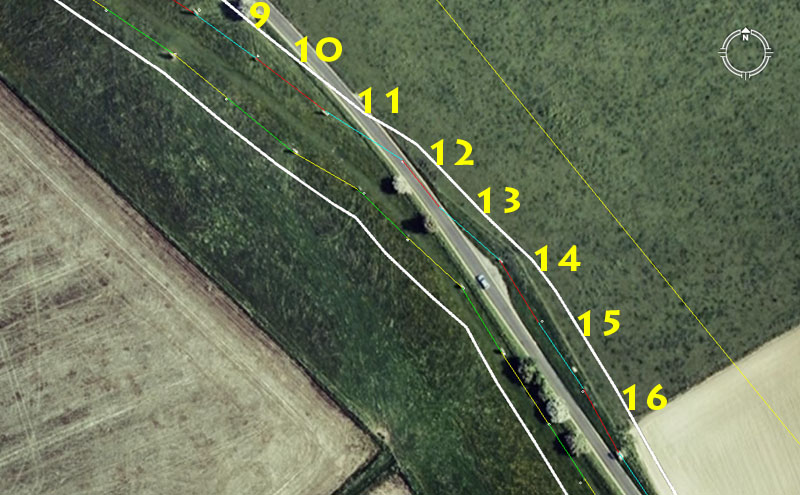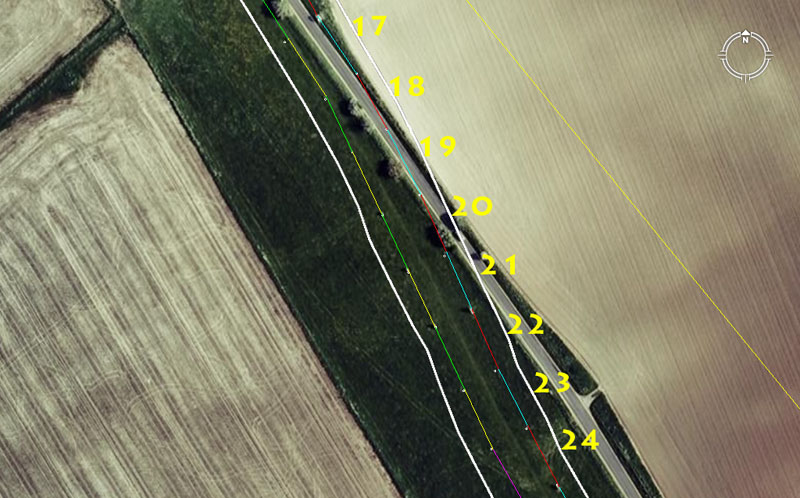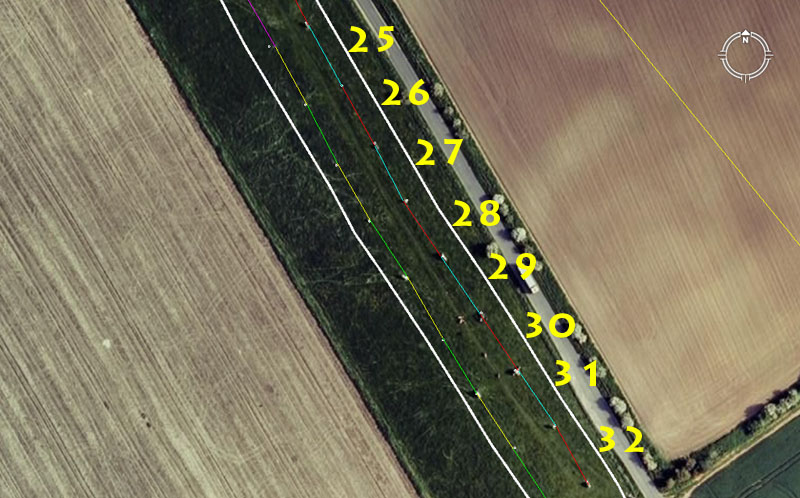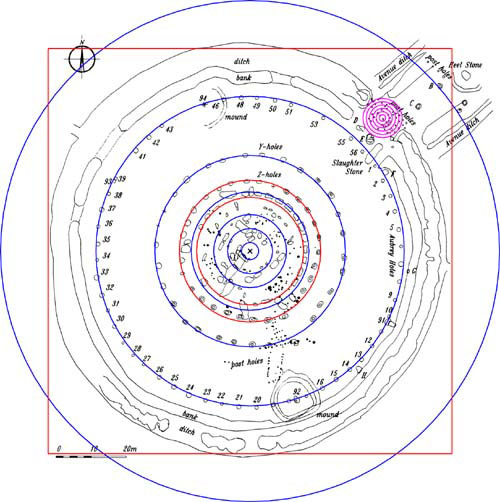
SAILING EVER FURTHER DOWN THE AVENUE

Leg 9.
The distance is 78.75-feet (1/8th of a Stadia) and the azimuth angle is 126-degrees.
Leg 10.
The distance is 90.72-feet (1/4000th of 1-degree of equatorial arc) and the azimuth angle is 127.27272727 (127 & 3/11ths).
Leg 11.
The distance is 93.3333333-feet and the return azimuth angle is 302.4-degrees.
Leg 12.
The distance is 63-feet (1/10th of a Stadia) and the azimuth angle is 141.75-degrees (dynamic lunar coding found on the Khafre Pyramid of Egypt, where two side lengths equalled 1417.5-feet).
Leg 13.
The distance is 82.03125 (1/64th of a mile of 5250-feet) and the azimuth angle is 131.25-degrees (in feet this is 1/40th of a 5250-feet mile).
Leg 14.
The distance is 75.6-feet (1/4800th of 1-degree of equatorial arc) and the return azimuth angle is 328.125-degrees (in feet this is 1/16th of a 5250-feet mile).
Leg 15.
The distance is 84-feet (1/4320th of 1-degree of equatorial arc) and the azimuth angle is 145.833333-degrees (in feet this is 1/36th of a 5250-feet mile).
Leg 16.
The distance is 75.6-feet and the azimuth angle is 151.2-degrees (in feet this is 1/40th of 1-minute of equatorial arc).

Leg 17.
The distance is 84-feet and the azimuth angle is 145.833333-degrees.
Leg 18.
The distance is 75.6-feet and the azimuth angle is 151.2-degrees.
Leg 19.
The distance is 87.5-feet (1/60th of a 5250-feet mile) and the azimuth angle is 152.7272727272-degrees.
Leg 20.
The distance is 74.6666666-feet (1/81st of 1-minute of equatorial arc) and the return azimuth angle is 336-degrees.
Leg 21.
The distance is 75.6-feet and the return azimuth angle is 336-degrees (in feet this would be 1/18th of 1-minute of equatorial arc).
Leg 22.
The distance is 78.75-feet and the return azimuth angle is 336-degrees.
Leg 23.
The distance is 75.6-feet and the azimuth angle is 152.7272727272-degrees (152 & 8/11ths).
Leg 24.
The distance is 84-feet and the azimuth angle is 152.7272727272-degrees.

Leg 25.
The distance is 82.0125-feet and the azimuth angle is 151.2-degrees.
Leg 26.
The distance is 78.75-feet and the azimuth angle is 151.2-degrees.
Leg 27.
The distance is 72.9166666666-feet (72 & 11/12ths... this length is 1/72nd of a 5250-feet mile) and the azimuth angle is 152.7272727272-degrees (152 & 8/11ths).
Leg 28.
The distance is 78.75-feet and the azimuth angle is 145.833333-degrees (145 & 5/6ths).
Leg 29.
The distance is 82.03125-feet and the azimuth angle is 145.833333-degrees.
Leg 30.
The distance is 78.75-feet and the azimuth angle is 145.83333333-degrees.
Leg 31.
The distance remains 78.75-feet and the angle is again 145.833333-degrees.
Leg 32.
The distance is 78.75-feet and the azimuth angle is 151.2-degrees.
The above lengths and angles connect in an unbroken (AutoCAD superimposed) line all the way down to this 32nd position of the eastern row. The same holds true of the 32 positions covered so far on the western row. It's logical to assume that some of the longer or wider marker stones afforded the opportunity to build extra, close-proximity, coded lengths (of the same navigational number family) and some variable angles into multiple positions down the avenue.
Beyond this point the occurrence of surviving stones or marker plinths becomes spasmodic, so we will leave the West Kennet Avenue analysis here for the moment and return to doing the northwestern sector of Avebury Henge itself.
ON "GETTING REAL"
It seems to have been the very mistaken conclusion of present-day academics that the thought processes and general personality traits of our distant Caucasoid ancestors were a radical departure away from how their progeny have traditionally thought and acted through ensuing ages. Our people have always been the bearers of high civilisation and advanced scientific thinking, spanning all recorded history. Despite this, we've lately been led to believe by "experts" that there was nothing of any scientific significance to be found at Avebury or, indeed at any of the megalithic monuments scattered across Britain or elsewhere around the world where the Caucasoid nations set up long-term civilisations.
Apparently, these great works and engineering feats were only done for banal-mundane, pseudo-senseless or even semi-depraved and superstitious reasons. We hear endless dribble and new-age waffle nonsense about the "fertility" and "Goddess" worship rituals as the "raison-d'etre" for Averbury or about cruel human sacrifice being associated with these ancient monuments (ad nauseam, ad infinitum). Very few so-called "scholarly" explanations make any sense at all, especially when one considers the more general thought processes, applied logic, intellectual reasoning or plausible approaches Caucasoid peoples traditionally take to any problem solving incentive.We have always been very adventurous, harboring an inherent wander-lust to explore the unknown reaches of the world. We have always been profoundly inquisitive or inventive, constantly seeking to improve in our knowledge within the sciences, trades, arts, crafts, social-systems, etc. If we wanted to travel internationally, we most certainly would have developed the positional plotting mathematics, the astronomical-map and essential methodologies to do so.
Yet we're led to believe, against an avalanche of evidence to the contrary, that our distant forebears were incapable of creating something as simple as a factorable measurement standard for widespread usage. Were told that they had no ability to navigate beyond sight of land or that they had no developed shipwright skills to build truly seaworthy craft, despite the fact that their ancient skeletons, artefacts and scripts, etc., are found the world over. We're told that they had no inkling of the concept of "zero", so could only come up with very rudimentary counting systems. We're led to believe that they couldn't manipulate simple fractions or conceive of PI, let alone the more complex ratio PHI. We're further told that they had no idea that the Earth was round, despite the fact that anyone can stand on a high hill looking out to sea and observe the curvature of the Earth on the horizon or look up and see a round sun and moon.
Without belaboring the point, it's time for European peoples to begin anew researching and writing their own true, reasonable and rational history, rather than allowing despising, resentful enemies and control freaks with political agendas to continue steering it or writing it for them. Our people are being heavily indoctrinated with politically-expedient, limited, pseudo-history about our origins, enlightened forebears and globetrotting accomplishments of the distant past, designed solely to disarm, demoralise and exploit in the present. The real truth about ancient Caucasoid-European history is virtually never heard these days, instead we're required to be self-effacing or accepting of all manner of unwarranted guilt and self-loathing for sins mostly never committed. At the same time, the ornate remnant structures, geometric earthmound complexes and extensive cultural symbolism, etc., etc., our very mobile ancient ancestors left on many continents around the globe have been "given away" to others.
National Geographics recently released a new, demeaning clanger about Stonehenge being nothing more or less than a "temple of the dead", even though the very sophisticated mathematical principles of Avebury Henge are glaringly apparent in every decipherable position or ring (set to PHI ratio reductions) within Stonehenge.

There is a complex PHI relationship built into the diameters
of the circles and other positions at the Stonehenge site.
By clicking the mouse on the picture, the reader will be able to move this red 3,4,5 triangle to any desired position around the Aubrey Circle. Remember that the ancient astronomers were using ropes, running to the sides of Aubrey Circle posts to form the 3,4,5 triangles. Carefully position this red triangle such that the "adjacent" and "hypotenuse" crossing vectors touch the sides of Aubrey Circle posts, then observe all other sides of the triangle to see the relationships. It will become quickly apparent that the Aubrey and other posts (or stones) were carefully positioned to relate to 3,4,5 triangulation onto the embankment (star alighting) circle.
Like the Sanctuary Circle at the end of the West Kennet Avenue, 3,4,5 triangle fixes were being done at Stonehenge. This site was a literal henge ("hinge" is derived from "henge") with an artificial-horizon, circumnavigating embankment, where stars could be observed to be ascending from the bank or alighting onto it. The 56 post positions on the Aubrey Circle provided stations for a swivelling 3,4,5 triangle made from taughtly pulled ropes, as in the manner shown above. Fixes onto the alighting or ascending positions of stars could be calculated by this means. Alternative tutorials would have related to navigational methods, using the known positions of stars. Other observatories, such as Mt. Pleasant at Dorchester, Dorset, England used the same methods, which undoubtedly duplicated what was happening at the Sanctuary Circle at Wiltshire.
Dr. Michael Parker Pearson's Stonehenge "Necropolis" idea is about as plausible as the one by that other "expert", who got world-wide attention in postulating that the huge blocks that built the pyramids were moved from the quarry to the building site using sails.
If you truly want know your history, then you're going to have to extract it from the landscape and forgotten archives yourself, without any hope of help from our PC-establishment academics, whose handlers forbid any such participation.